This is a dynamic list and may never be able to satisfy particular standards for completeness. You can help by adding missing items with reliable sources.


The following digital cameras allow photos to be taken and saved in at least one raw image format. Some cameras support more than one, usually a proprietary format and Digital Negative (DNG).
The following cameras allow audio and video to be shot in at least one raw (often similar to raw image format, but also with proprietary YCbCr and RGB coding and/or lossy wavelet compression) format.
With AJA CamXChange software on OS-X Yosemite via Thunderbolt Port (DCI 4K to 30fps), CineDNG format. With AJA CamXChange (or Possibly AJA Control Room - unconfirmed by owners) using AJA Io-4K in single or dual-link 3G-SDI (DCI 4K up to 60fps), or AJA Kona4 PCIe card to Raid Array (DCI 4K up to 120fps), all in CineDNG format.
With proprietary ArriRaw and HDMI or HD-SDI uncompressed video format.
Unofficially, with the use of Magic Lantern software, the following EOS cameras can record RAW video:
With proprietary REDCODE raw format with lossy compression for video.
Some Nikon Coolpix cameras which are not advertised as supporting a RAW image format can actually produce usable raw files if switched to a maintenance mode. [26] Note that switching to this mode can invalidate a camera's guarantee. Nikon models with this capability:
E700, E800, E880, E900, E950, E990, E995, E2100, E2500, E3700, E4300, E4500.
Some Canon PowerShot cameras with DiGiC II and certain DiGiC III image processors which are not advertised as supporting a RAW format can actually produce usable raw files with an unofficial open-source firmware add-on by some users. [27]
The Nokia N900 mobile phone has an add on app "Fcam", which allows capture and saving of RAW files in Adobe's DNG format (along with other advanced features usually found in DSLRs). In 2013, Nokia launched Nokia Lumia 1520 and Nokia Lumia 1020 smartphones with DNG RAW format. [28]
Samsung Galaxy Note 5, Note 7, Galaxy S6 Edge+, S7 and S7 Edge also support RAW image capture. Not to mention LG G4, LG G5, iPhone 6s (Plus), iPhone SE, iPhone 7 (Plus) iPad Pro and some other modern phones - OnePlus One, OnePlus Two, OnePlus 3(T), etc.

A digital camera is a camera that captures photographs in digital memory. Most cameras produced today are digital, largely replacing those that capture images on photographic film. Digital cameras are now widely incorporated into mobile devices like smartphones with the same or more capabilities and features of dedicated cameras. High-end, high-definition dedicated cameras are still commonly used by professionals and those who desire to take higher-quality photographs.

A digital single-lens reflex camera is a digital camera that combines the optics and the mechanisms of a single-lens reflex camera with a digital imaging sensor.

Advanced Photo System type-C (APS-C) is an image sensor format approximately equivalent in size to the Advanced Photo System film negative in its C ("Classic") format, of 25.1×16.7 mm, an aspect ratio of 3:2 and Ø 31.15 mm field diameter. It is therefore also equivalent in size to the Super 35 motion picture film format, which has the dimensions of 24.89 mm × 18.66 mm and Ø 31.11 mm field diameter.
A camera raw image file contains unprocessed or minimally processed data from the image sensor of either a digital camera, a motion picture film scanner, or other image scanner. Raw files are named so because they are not yet processed and therefore are not ready to be printed, viewed or edited with a bitmap graphics editor. Normally, the image is processed by a raw converter in a wide-gamut internal color space where precise adjustments can be made before conversion to a viewable file format such as JPEG or PNG for storage, printing, or further manipulation. There are dozens of raw formats in use by different manufacturers of digital image capture equipment.

Bridge cameras are cameras that fill the niche between relatively simple point-and-shoot cameras and interchangeable-lens cameras such as mirrorless cameras and single-lens reflex cameras (SLRs). They are often comparable in size and weight to the smallest digital SLRs (DSLR), but lack interchangeable lenses, and almost all digital bridge cameras lack an optical viewfinder system. The phrase "bridge camera" has been in use at least since the 1980s, and continues to be used with digital cameras. The term was originally used to refer to film cameras which "bridged the gap" between point-and-shoot cameras and SLRs.

Live preview is a feature that allows a digital camera's display screen to be used as a viewfinder. This provides a means of previewing framing and other exposure before taking the photograph. In most such cameras, the preview is generated by means of continuously and directly projecting the image formed by the lens onto the main image sensor. This in turn feeds the electronic screen with the live preview image. The electronic screen can be either a liquid crystal display (LCD) or an electronic viewfinder (EVF).

An image processor, also known as an image processing engine, image processing unit (IPU), or image signal processor (ISP), is a type of media processor or specialized digital signal processor (DSP) used for image processing, in digital cameras or other devices. Image processors often employ parallel computing even with SIMD or MIMD technologies to increase speed and efficiency. The digital image processing engine can perform a range of tasks. To increase the system integration on embedded devices, often it is a system on a chip with multi-core processor architecture.
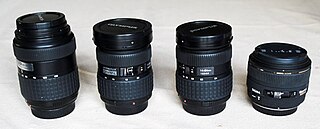
This article is about photographic lenses for single-lens reflex film cameras (SLRs) and digital single-lens reflex cameras (DSLRs). Emphasis is on modern lenses for 35 mm film SLRs and for DSLRs with sensor sizes less than or equal to 35 mm ("full-frame").
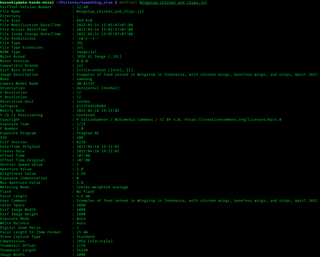
ExifTool is a free and open-source software program for reading, writing, and manipulating image, audio, video, and PDF metadata. It is platform independent, available as both a Perl library (Image::ExifTool) and command-line application. ExifTool is commonly incorporated into different types of digital workflows and supports many types of metadata including Exif, IPTC, XMP, JFIF, GeoTIFF, ICC Profile, Photoshop IRB, FlashPix, AFCP and ID3, as well as the manufacturer-specific metadata formats of many digital cameras.

The Micro Four Thirds system is a standard released by Olympus and Panasonic in 2008, for the design and development of mirrorless interchangeable lens digital cameras, camcorders and lenses. Camera bodies are available from Blackmagic, DJI, JVC, Kodak, Olympus, Panasonic, Sharp, and Xiaomi. MFT lenses are produced by Cosina Voigtländer, DJI, Kowa, Kodak, Mitakon, Olympus, Panasonic, Samyang, Sharp, Sigma, SLR Magic, Tamron, Tokina, TTArtisan, Veydra, Xiaomi, Laowa, Yongnuo, Zonlai, Lensbaby, Kowa, Venus Optics and 7artisans amongst others.

The Panasonic Lumix DMC-G1 was the first digital mirrorless interchangeable-lens camera (MILC) adhering to the Micro Four Thirds system design standard. The G1 camera is similar to the larger Four Thirds system format DSLR cameras, but replaces the complex optical path needed for the optical viewfinder with an electronic viewfinder EVF displaying a live view image directly from the sensor. Eliminating the mirror box and optical viewfinder allows for smaller and lighter camera bodies, while the less complex optical path also allows for smaller, lighter lens designs.

An articulating screen is a built-in small electronic visual display which is not fixed, but rather can be repositioned using a hinge or pivot. The articulating screen is known under different other names such as flip-out screen, flip screen, adjustable screen, articulated screen, or hinged screen. According to the way it moves, there are four main types:

A mirrorless camera is a photo camera featuring a single, removable lens and a digital display. The camera does not have a reflex mirror or optical viewfinder like a digital single-lens reflex (DSLR) camera, but may have an electronic viewfinder. Many mirrorless cameras retain a mechanical shutter. Like a DSLR, a mirrorless camera accepts any of a series of interchangeable lenses compatible with its lens mount.
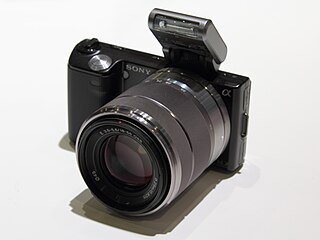
The Sony α NEX-5 is a digital camera launched on 11 May 2010. It is a mirrorless interchangeable lens camera with the body size of a larger model fairly compact point-and-shoot camera with a larger sensor size (APS-C) comparable to that of some digital single-lens reflex cameras. Its major competitors in the market are the cameras based on the micro 4/3 standard created by Panasonic and Olympus, and a few low end Canon, Nikon, and even Sony α DSLRs. The NEX-5 shoots 14.2 megapixel stills and has a 7 frame/s continuous shotmode. It has the capability to shoot 1920×1080i at 60 frame/s in AVCHD or 1440×1080p at 30 frame/s in MPEG4. The NEX-5 was replaced by the 16 megapixel NEX-5N in August 2011.
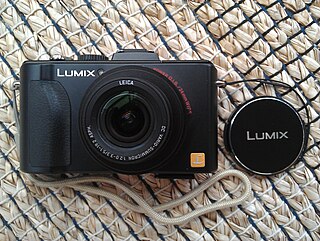
The Panasonic Lumix DMC-LX5, or LX5, is a high-end compact "point and shoot" camera launched by Panasonic in 2010 to succeed the LX3.
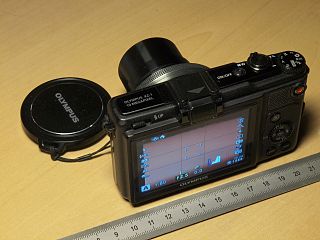
The Olympus XZ-1 is a high-end 10.0 megapixel compact digital camera announced and released in January 2011. Its key features are a fast f/1.8-2.5 i.Zuiko Digital lens, a built in imager shift image stabilizer and Olympus' 6 Art Filters that are also present in the E-PEN series.

The Panasonic Lumix DMC-G2 is a digital mirrorless interchangeable lens camera adhering to the Olympus and Panasonic developed Micro Four Thirds System (MFT) system design standard. It was announced in March 2010 along with a lesser featured Panasonic Lumix DMC-G10.